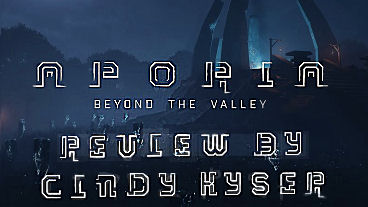
Aporia: Beyond the Valley
Aporia is a worthy addition to the genre that true adventurers should not miss







Genre: 3D Exploration/Adventure
Release date: July 19, 2017
Aporia: Beyond the Valley is a 3D exploration game created by Sebastian Bevensee, Kasper Boisen, and Mikael Olsen. It’s played from the first-person perspective of an unknown traveler who awakes in the lost world of Ez’rat Qin. The game is unique in that it has no dialog, no narration, and no text instructions. The story is told using still and moving pictographs. Visual cues are given when a specific key/mouse or controller action is required. There is occasional music in the background but, for the most part, it is a quiet game with only the very realistic sounds of the environment around you. Footsteps echo, water splashes, night creatures call, and cogs turn.
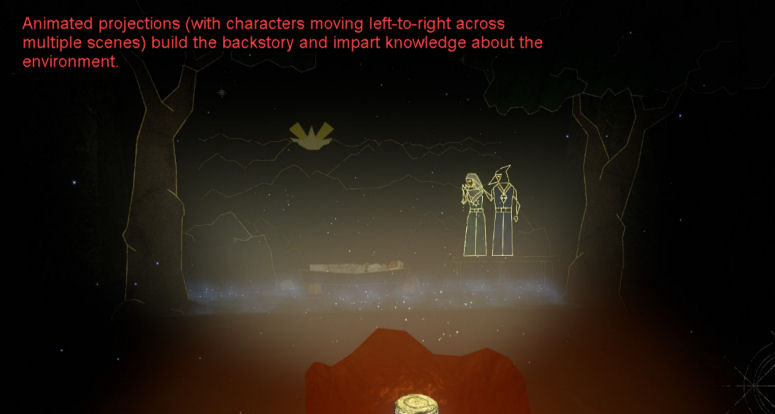
I looked up the word “Aporia” and Webster’s was little help. Wikipedia provided more insight by tracing it back to the Ancient Greek root. In that context, it means “impasse, difficulty of passing, lack of resources…” and denotes a philosophical puzzle or state of puzzlement. When used in rhetoric, it means “a professed doubt about where to begin.” Pretty abstract stuff, but it feels right once you’ve played the game.
Aporia opens with a suggestion that you “save your game often.” This elicited a standing ovation from me…a game with an explicit save option and multiple save slots! Woohoo! This increasingly rare feature makes a huge difference because I can relax and play, knowing that I can stop at any time and return to my exact exit point. I began this adventure with a happy face! I also started playing with a controller and soon found that, for me, navigation and actions were easier with a keyboard (WASD) and mouse (Aporia uses the directional pads on the controller for movement and does not use the joystick).
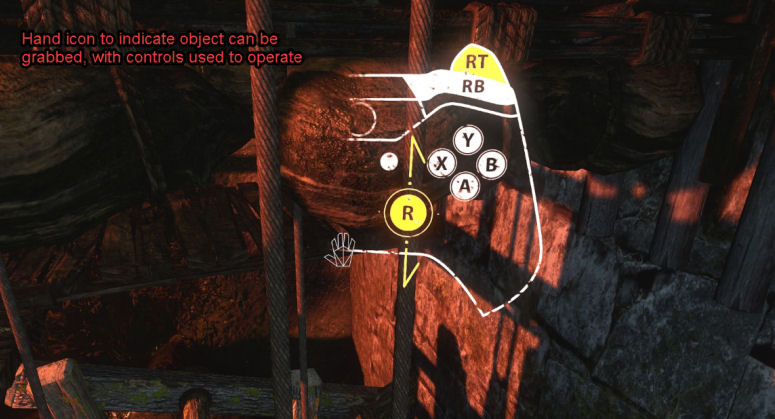
Your first task is to grab a “light bar” and discover how it is powered. Remember, there are no words in this game. A series of projected animations and wall murals provide full instruction on game mechanics, the culture of Ez’rat Qin, and the fate of its people. You learn that the light bar is multi-purpose: to provide illumination (thank you, Captain Obvious!), to open doors and to stimulate plant growth. You also learn that certain plants are of special interest due to their healing properties or structural strength.
As you play, you must manage the “charge” on your light bar and your own health level. The light bar is charged via a golden liquid that is scattered about in flasks and kegs. Your health is regenerated by finding (or growing) the proper plant and consuming it. There is no advantage to hoarding, as using resources when you are healthy or fully charged does nothing but remove them from the environment. By using items only when needed, there was always plenty when my levels ran low later in the game.
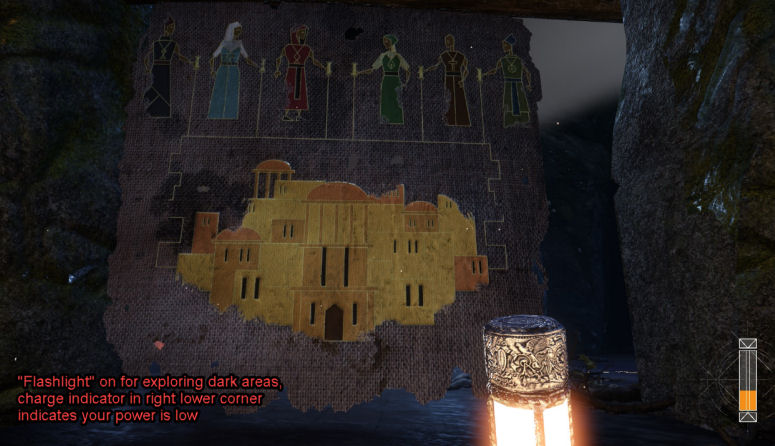
Aporia is logically divided into five segments. The initial segments get you familiarized with the game, let you exercise your puzzle-solving skills and move you towards the central temple in the main valley. Each segment is strikingly beautiful to experience and diverse enough to make it an incredibly interesting journey. Take your time to soak everything in, as you will not be able to revisit an area once a segment is completed.
The middle segment is called “The Long Walk” and it is just that. The valley is HUGE, with ruins, pathways, caves, tunnels, aqueducts, waterfalls, and a variety of puzzles. It can be explored in any order and a map is provided to help the gamer who is geographically challenged. There is a large temple that provides a virtual “hub” for this area and you are returned there when certain tasks are completed. Artwork is scattered throughout the valley and each communicates something about the backstory.
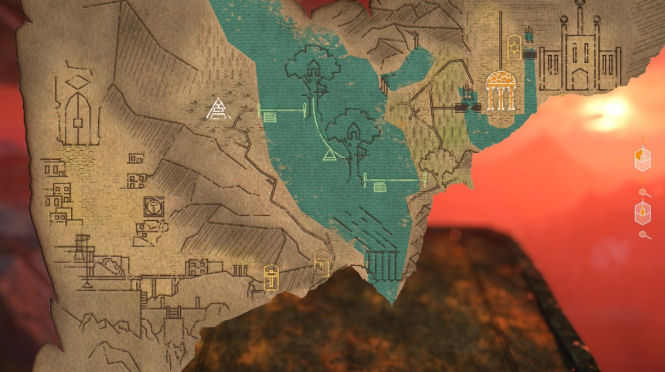
In the valley, I began finding “colored bits” that could be grabbed. There is no inventory to manage, but for some objects, a count of how many you are carrying is tabulated. It took me awhile to understand the meaning of the icons and numbers that were displayed when I grabbed a “countable” object. The actual counts are only visible when you pick up (or put down) an item, so it was not initially clear to me that I was accumulating hidden inventory. Single-use objects (such as levers) are carried until needed and automatically used. If a machine appears to be missing a part, you may need to retrace steps to find it.
I was well into Aporia when I realized that the aforementioned “colored bits” might be important. You do not have to find all of them to complete the game but I am not a fan of “unfinished business.” YIKES! I hadn’t been really looking for them and had no idea where I’d found the handful I’d picked up. Since I was enjoying the game, I decided to restart the chapter and search, in earnest. The second time through, I explored every nook and cranny, solved all puzzles, and kept a list of where I’d found each of the mysterious items. At the end, I was still missing two. Sigh… Should I stay or should I go? After a few more hours of searching without success, I violated my own personal code of conduct and did the unthinkable. I went to YouTube for help and discovered that my missing items were in less-than-obvious locations.
Midway through “The Longest Walk” you have the option of leaving the valley and proceeding to the next segment. Thus, you can shortcut to the end of the game if you are so inclined. I made sure that I did not make this choice until I was (almost) positive that I had done everything possible in the valley.The final segments take you through equally beautiful environments with more puzzles that move you towards the ending. Ultimately, there is a decision to make and the path you choose impacts the outcome of the story. I had “saved my game often” so I went back and was able to view the effect of a different choice.
To sum it up, I loved playing Aporia and did not want it to end. The game is beautiful to behold and the 3D world is created in unbelievable detail. The first-person perspective is done so well that you almost believe that Ez’rat Qin is a real place. You can take in the scenery from numerous vistas. You cross suspended pathways, swim through lakes, fall through scaffolding, operate primitive machinery, jump stone platforms and pilot a boat. Each experience feels as if you are truly going through the real-life mechanics of the actions. I should note that I never did get the hang of descending a ladder. Luckily, jumping or “stepping off” only resulted in minor injuries!
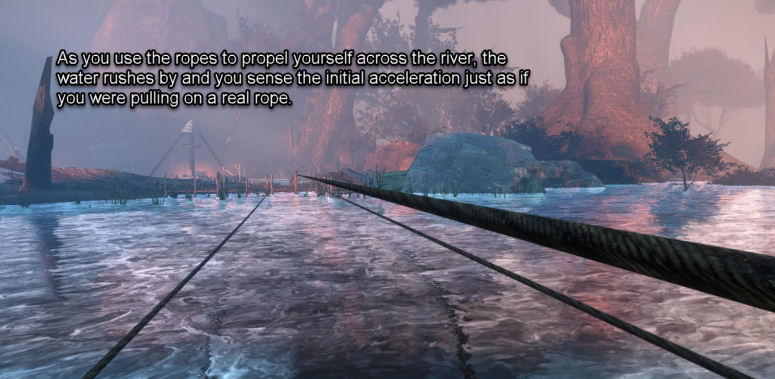
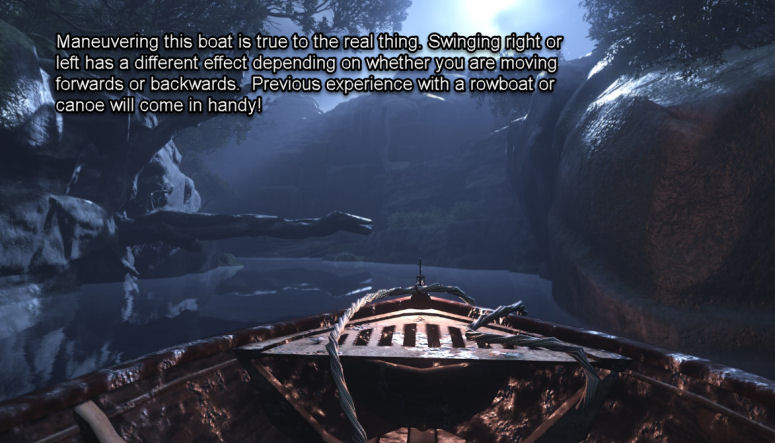
The weather changes from sunshine to rain, time passes from night to day, clouds form and mist rises from the river. Lamps flicker and your flashlight plays on shadows in the dark, as areas explored in the daylight take on completely different qualities at night. Aporia is a constantly changing world that continued to delight me, from start to finish.
As in real life, exploration can be a risky business. I fell to my death when I missed a jump or stumbled while crossing a narrow bridge. I drowned a few times and suffocated from toxic fumes. The game is forgiving and I was immediately returned to the moment just before death, with no replay required. My travels were filled with “near-fatal” accidents and I used healing plants to restore my health and continue without interruption.
The puzzles make sense and are not difficult. They are mechanical in nature and include using weights to position stone platforms, aiming mirrors to reflect light, aligning symbols, rerouting water flows. Each is unique and requires planning. Except for the “colored bits” puzzle, everything you need to master a specific scenario is usually close at hand.
To keep things interesting, you get to use your platforming skills on occasion and you may encounter a wraith-like spirit that means you harm. There is enough challenge to keep the game interesting but never enough to send me scurrying for a walkthrough. I spent 21 hours playing Aporia, including my restart. I never grew tired of the game and had to force myself to stop playing in order to get back to “real life” responsibilities (like sleeping!). In truth, I could have spent twice as much time in Ez’rat Qin and not complained!
For me, the last few months have represented a real renaissance in adventure gaming – a period during which I have had the privilege of playing some phenomenal games. Aporia: Beyond the Valley is an experience that has everything I love about this genre – incredible artwork, immersive sound, a solid story, leisurely exploration and puzzles that made me think. Revealing a story through pictographs is an interesting concept and adds a layer of depth that is absent from many “empty landscape” games. More and more, I am beginning to favor an immersive 3D environment over 2D point-and-click. And the occasional need to exercise my jumping, climbing or evasion skills kept me on my toes. Aporia is a worthy addition to the genre that true adventurers should not miss.
|
+ Beautifully crafted traditional adventure
+ Although the segments are linear, within each segment you are free chart your own course and explore at your leisure
+ Environmental changes, coupled with diverse game elements, make this an interesting journey from start to finish
+ Mechanical puzzles add challenge but can be solved with logic and local clues
+ Explicit Save option lets you exit without requiring replay
No minuses
|
 |
System Requirements
Processor: Dual Core 3 GHz processor
Graphics: Nvidia GeForce GTX 660 or similar

Leave a Reply